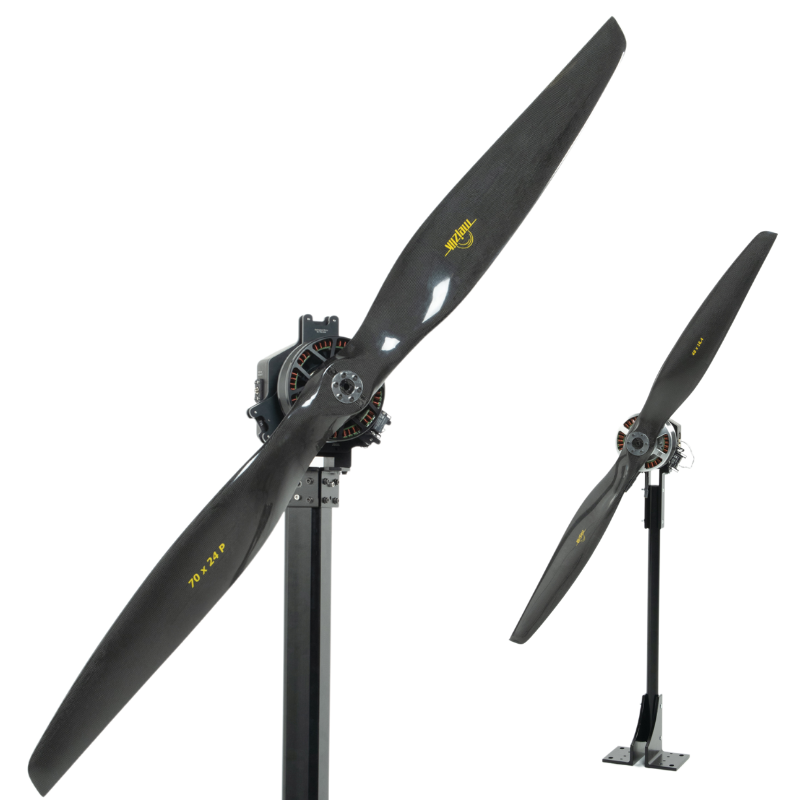By Lauren Nagel
‘Winding Resistance’ is a figure you’ve probably seen in an electric motor datasheet. It may not be the first thing you look for, but it can be useful.
In this article we will explain what this value represents and how you can use it to benefit your project.
Table of Contents
- What is motor winding resistance
- Winding resistance and motor performance
- Motor winding resistance test - with an ohmmeter
- How to use motor winding resistance in your project

1. What is Motor Winding Resistance
Motor winding resistance is a fundamental property of the wire coils that make up the stator and rotor of an electric motor. It is a measure of how much the wire coils impede the flow of electric current through them.
The resistance in the wire causes some of the electrical energy to be converted into heat, which is associated with a lower motor efficiency. Additionally, this heat can cause the motor to overheat and eventually fail, which is why it is essential to ensure that the winding resistance is within a safe range.
Winding resistance is a function of the length, cross-sectional area (gauge), and resistivity of the wire used in the coils, as well as the number of turns in the coil. It is also affected by the temperature of the motor, with higher temperatures resulting in increased resistance due to the increased vibration and collision rate of the metal ions.
Further reading: How Brushless Motors Work & How to Test Them
2. Winding Resistance and Motor Performance
The winding resistance of an electric motor plays a critical role in determining its performance characteristics. For example, higher winding resistance results in lower power output, lower efficiency, and increased heat losses.
Conversely, lower winding resistance can lead to excessive current draw, which can damage the motor and associated equipment. Therefore, it is useful to measure and monitor the winding resistance of electric motors to ensure optimal performance and prevent damage.
Winding resistance is typically determined by measuring the voltage and current in the motor. The resistance is then calculated using Ohm's law, which states that resistance is equal to voltage divided by current.
This measurement can be used to detect faults in the coil, such as short circuits or broken wires, and can also be used to diagnose other issues in the motor, such as problems with the bearings or drive circuitry.
Further Reading: How to Measure Brushless Motor Efficiency

3. Motor Winding Resistance Test
An easy way to measure motor winding resistance is using an ohmmeter/ multimeter. Here’s how it’s done.
How to Use a Multimeter to Measure Motor Winding Resistance:
- Turn off the power to your motor.
- Access the motor's winding: you may need to remove a cover or disassemble the motor to access the winding.
- Identify the winding terminals: look for the motor's wiring diagram or markings on the terminals to identify the winding's start and end points.
- Turn on the ohmmeter/ multimeter: if you’re using a multimeter, select the ohmmeter function. Choose the appropriate range for the expected resistance value of your motor's winding. If you're not sure, start with the highest range and work your way down.
- Connect the probes: connect the meter's probes to the winding terminals. Make sure that the probes are making good contact and that there are no short circuits.
- Pass a test current through the wire: the value of the test current should be selected according to the nominal winding current. The test current should not exceed 10% of the nominal winding current.
- Read the resistance: Take note of the resistance value displayed on the meter. If the value is within the manufacturer's recommended range, then your motor's winding is likely functioning correctly. If the value is outside the range, then there may be a problem with the winding or the motor.
- Calculate the winding resistance: use Ohm's law to calculate the winding resistance. To do this, divide the voltage applied to the winding by the resulting current. For example, if the voltage across the winding is 10 volts and the resulting current is 1 ampere, the winding resistance is 10 ohms (R = V/I).
- Repeat the test: To ensure accuracy, it's a good idea to repeat the test a few times and take an average of the readings.
Further reading: Brushless Motor Power and Efficiency Analysis

4. How to Use Motor Winding Resistance in Your Project
Electric motor manufacturers provide the winding resistance of a motor as a specification to help customers understand the motor's electrical characteristics and performance capabilities.
Here are some of the ways you can use motor winding resistance in your project:
- To make a model of the motor: the winding resistance can allow you to make a model of your motor, which can be useful in the design phase. To make a proper theoretical model you also need to know what kind of winding you have in your motor (wye or a delta). In practice, we have noticed that there's often significant differences between the experimental and theoretical models (>30% error on certain measurements), so we also recommend testing your motors with a thrust stand to estimate performance.
- Verification of motor design: customers can verify that their motor conforms to the design and performance specifications provided by the manufacturer. By measuring the winding resistance, customers can check that the motor's wire gauge, number of turns, and other design parameters are consistent with what was promised.
- Optimization of motor performance: winding resistance can help customers select the appropriate drive circuitry and load characteristics for best performance. For example, higher winding resistance can result in increased heating and lower efficiency, while lower resistance can lead to excessive current draw and damage to the motor.
- Diagnosis of motor faults: a significant deviation from the manufacturer's specified resistance value could indicate a fault, such as a broken or shorted winding.
- Selecting an ideal motor-propeller combination: motors with higher winding resistance typically have lower torque but can spin faster with smaller propellers, while motors with lower resistance have higher torque and are better suited for larger propellers.
- Calculation of motor efficiency: by measuring the current draw and voltage across the motor, the drone builder can calculate the power consumed by the motor. The winding resistance can be used to calculate the power dissipated as heat. By comparing the power consumed to the power dissipated, the user can estimate the motor’s efficiency.
Conclusion
In summary, motor winding resistance can be a useful figure for your project, and it is easy to measure with a multimeter.
It can help you select the appropriate motor and propeller combination, design the motor drive circuitry, identify faults in the motor, and calculate the motor efficiency.
By considering the winding resistance along with other electrical characteristics, drone builders can optimize the performance of their drone and promote reliable operation.
If you would like to get started characterizing your electric motors, check out our motor testing tools:
- Series 1585 - measures up to 5 kgf of thrust / 2 Nm of torque
- Flight Stand 15 - measures up to 15 kgf of thrust / 8 Nm of torque
- Flight Stand 50 - measures up to 50 kgf of thrust / 30 Nm of torque
- Flight Stand 150 - measures up to 150 kgf of thrust / 150 Nm of torque
- Flight Stand 500 - measures up to 500 kgf of thrust / 1500 Nm of torque


 Back to Blog
Back to Blog


Thank. You
July 30, 2024
Your. Information very good